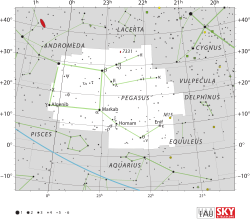Theta Pegasi
| Observation data J2000.0
| ||
|---|---|---|
| Constellation | Pegasus | |
| Right ascension | 22h 10m 11.98528s[1] | |
| Declination | +06° 11′ 52.3078″[1] | |
| Apparent magnitude (V) | +3.52[2] | |
| Characteristics | ||
| Evolutionary stage | main sequence[3] | |
| Spectral type | A2V[4] + M4-5.5[5] | |
| B−V color index | 0.086±0.002[2] | |
| Absolute magnitude (MV) | 1.24[2] | |
Inclination (i) | 66.7+8.5 −14° | |
| Details | ||
| θ Peg A | ||
Myr | ||
| θ Peg B | ||
| Mass | 0.280+0.18 −0.059[5] M☉ | |
| Surface gravity (log g) | 5.5[5] cgs | |
| Temperature | 3200[5] K | |
| Database references | ||
| SIMBAD | data | |
θ Pegasi,
light years from the Sun based on parallax, but is drifting closer with a radial velocity of −8 km/s.[2]
This object an
mass of the Sun and 2.6[12] times the Sun's radius. It is radiating 25 times the luminosity of the Sun from its outer envelope at an effective temperature of 7,951 K.[12] The star appears to display a slight infrared excess.[13]
θ Pegasi was suspected of being a
au.[5]
Nomenclature
θ Pegasi (Latinised to Theta Pegasi) is the star's Bayer designation.
It bore the traditional name Biham or Baham from the Arabic phrase s'ad al Biham "Lucky Stars of the Young Beasts".[14] In 2016, the International Astronomical Union organized a Working Group on Star Names (WGSN)[15] to catalogue and standardize proper names for stars. The WGSN approved the name Biham for this star on 21 August 2016 and it is now so entered in the IAU Catalog of Star Names.[11]
In
References
- ^ S2CID 18759600.
- ^ S2CID 119257644.
- S2CID 55586789.
- ^ S2CID 14911430, 40. See Table 3.
- ^ S2CID 244399987.
- ^ S2CID 33401607.
- ^ "tet Peg". SIMBAD. Centre de données astronomiques de Strasbourg. Retrieved 2019-08-31.
{{cite web}}: CS1 maint: postscript (link) - S2CID 88503488.
- ISBN 9781447102274.
- ISBN 978-1-931559-44-7.
- ^ a b IAU Catalog of Star Names, IAU, retrieved 28 July 2016.
- ^ S2CID 18993744.. See Table 10.
- S2CID 44229077, A113.
- ^ Kaler, James B. (October 15, 2010), "Biham", STARS.
- ^ IAU Working Group on Star Names (WGSN), International Astronomical Union, retrieved 22 May 2016.
- ISBN 978-986-7332-25-7.
- ^ (in Chinese) 香港太空館 - 研究資源 - 亮星中英對照表 Archived 2010-08-11 at the Wayback Machine, Hong Kong Space Museum. Accessed on line November 23, 2010.

